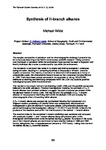Synthesis of H-branch alkanes
| dc.contributor.author | Wilde, M. | |
| dc.date.accessioned | 2019-05-16T12:15:38Z | |
| dc.date.available | 2019-05-16T12:15:38Z | |
| dc.date.issued | 2014 | |
| dc.identifier.citation |
Wilde, M. (2014) 'Synthesis of H-branch alkanes', The Plymouth Student Scientist, 7(1), p. 50-99. | en_US |
| dc.identifier.issn | 1754-2383 | |
| dc.identifier.uri | http://hdl.handle.net/10026.1/14052 | |
| dc.description.abstract |
The complex composition of petroleum and the chromatographic challenge it presents has led to its study becoming a key field in contemporary scientific research. Rising concerns over the impact of petroleum within the environment have spurred the need to fingerprint and identify individual oils in order to understand its fate within the environment. The complexity of petroleum lies solely in its origins and thermal processes it undergoes during formation, resulting in it containing hundreds of thousands of different, unknown organic compounds. The majority of petroleum is observed in GC analysis as a ‘hump’ of unresolvable peaks; this characteristic hump is known as the Unresolved Complex Mixture or UCM. There have been several advances in the separation of oil e.g. GC×GC-MS, dedicated to resolving and identifying compounds within the UCM that could be potential toxicological hazards within the environment. This has led to the unique method of synthesising model UCMs and the possible compounds believed to be within petroleum. Previous investigations, involving the synthesis of C19 T-branch alkanes have provided evidence to suggest that such structures are present within the aliphatic fraction of some UCMs. This has led onto the synthesis of C19 H-branch alkanes for the purpose of identifying them within the aliphatic UCM and studying the chromatographic effect of branching within alkanes. A C19 H-branch alkane was successfully synthesised following the improvement of a Grignard reaction, producing a 3° alcohol which was subsequently dehydrated and hydrogenated to give the desired 5,7-substituted alkane. Comprehensive analysis was performed throughout the investigation, utilising FT-IR, GC-FID and GC-MS, to identify the products of the reactions and confirm the final structure of the desired H-branch alkane. The retention index for the completed H-branch subdivision was calculated and compared with previously studied H- and T-branch alkanes along with pristane; prior to this investigation commonly known to be the earliest eluting C19 alkane. As a result of this study, two of the H-branch alkanes are now known to have retention indices of 1688 and 1692 Kovats, being lower than n-heptadecane and pristane at 1707 Kovats, making them some of the earliest eluting C19 branched alkanes. | en_US |
| dc.language.iso | en | en_US |
| dc.publisher | University of Plymouth | |
| dc.rights | Attribution 3.0 United States | * |
| dc.rights.uri | http://creativecommons.org/licenses/by/3.0/us/ | * |
| dc.subject | H-branch alkanes | en_US |
| dc.subject | chromatography | en_US |
| dc.subject | FT-IR | en_US |
| dc.subject | GC-FID | en_US |
| dc.subject | GC-MS | en_US |
| dc.subject | Unresolved Complex Mixture | en_US |
| dc.subject | synthesis | en_US |
| dc.title | Synthesis of H-branch alkanes | en_US |
| dc.type | Article | |
| plymouth.issue | 1 | |
| plymouth.volume | 7 | |
| plymouth.journal | The Plymouth Student Scientist |



